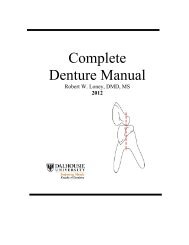RPD Manual 11 - Removable Prosthodontics - Dalhousie University
RPD Manual 11 - Removable Prosthodontics - Dalhousie University
RPD Manual 11 - Removable Prosthodontics - Dalhousie University
You also want an ePaper? Increase the reach of your titles
YUMPU automatically turns print PDFs into web optimized ePapers that Google loves.
Surveying, Path of Insertion, Guiding Planes - 16<br />
Selecting the Path of Insertion of a <strong>Removable</strong> Partial Denture<br />
A path of insertion is selected to provide the best combination of retentive undercuts and<br />
parallel surfaces for ALL ABUTMENTS. Use the following steps to do so:<br />
STEP 1 Place the cast on the surveyor table and orient the plane of occlusion relatively<br />
horizontal. The final tilt of the cast for the ideal path of insertion is seldom more<br />
than 10° from this position.<br />
STEP 2 Place the analyzing rod against the axial surface of a proposed abutment teeth (any<br />
tooth adjacent an edentulous space). The tip of the rod should be at the level of the<br />
free gingival margin. The point where the tooth touches the analyzing rod is greatest<br />
convexity (bulge) of a tooth and is called the height of contour.<br />
The position of the height of contour can be changed by tilting the cast. The area on a<br />
tooth occlusal to the height of contour is called the suprabulge area. All portions of<br />
a direct retainer that are rigid or semi-rigid must be located in this area. The area<br />
gingival to the height of contour is an undercut and is called the infrabulge area.<br />
The retentive portions of direct retainers are located in this area, since they can flex to<br />
pass over the height of contour.<br />
Note that when cast is tilted and the surveying arm remains vertical, the height of contour (large<br />
arrows) changes, as does the distance of the analyzing rod to the tooth (small arrows)<br />
STEP 3 Tilt the cast to gain maximum parallelism of axial surfaces of all of the proposed<br />
abutments. Maximum parallelism is present when the heights of contour of all teeth<br />
and all surfaces are as close as possible to the same position occluso-gingival. An<br />
additional check for maximum parallelism is that equal amounts of undercut are<br />
present on all abutments and all abutment surfaces. Check the mesial and distal tooth<br />
surfaces while tilting the cast anterior-posteriorly (A-P). While maintaining the same<br />
A-P tilt check facial and lingual parallelism. Lock the tilt of the cast when maximum<br />
parallelism is achieved.<br />
STEP 4 Use an undercut gauge to check for adequate and relatively equal retentive,<br />
undercuts for retentive arms on all abutments. Alter the tilt of cast if required.















